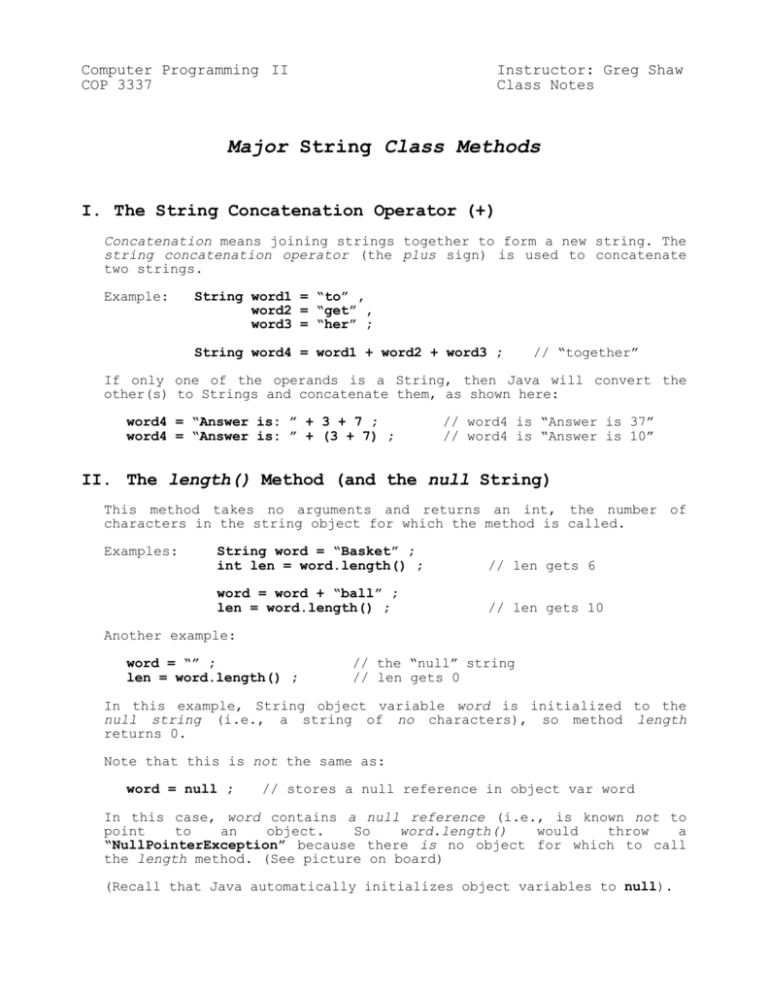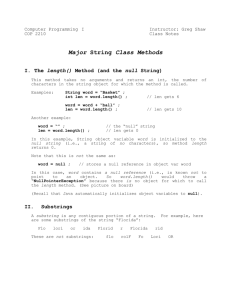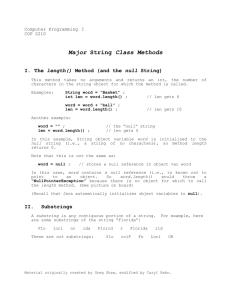Major String Class Methods
advertisement

Computer Programming II
COP 3337
Instructor: Greg Shaw
Class Notes
Major String Class Methods
I. The String Concatenation Operator (+)
Concatenation means joining strings together to form a new string. The
string concatenation operator (the plus sign) is used to concatenate
two strings.
Example:
String word1 = “to” ,
word2 = “get” ,
word3 = “her” ;
String word4 = word1 + word2 + word3 ;
// “together”
If only one of the operands is a String, then Java will convert the
other(s) to Strings and concatenate them, as shown here:
word4 = “Answer is: ” + 3 + 7 ;
word4 = “Answer is: ” + (3 + 7) ;
// word4 is “Answer is 37”
// word4 is “Answer is 10”
II. The length() Method (and the null String)
This method takes no arguments and returns an int, the number of
characters in the string object for which the method is called.
Examples:
String word = “Basket” ;
int len = word.length() ;
// len gets 6
word = word + “ball” ;
len = word.length() ;
// len gets 10
Another example:
word = “” ;
len = word.length() ;
// the “null” string
// len gets 0
In this example, String object variable word is initialized to the
null string (i.e., a string of no characters), so method length
returns 0.
Note that this is not the same as:
word = null ;
// stores a null reference in object var word
In this case, word contains a null reference (i.e., is known not to
point
to
an
object.
So
word.length()
would
throw
a
“NullPointerException” because there is no object for which to call
the length method. (See picture on board)
(Recall that Java automatically initializes object variables to null).
III. Substrings
A substring is any contiguous portion of a string.
are some substrings of the string “Florida”:
Flo
lori
or
ida
Florid
These are not substrings:
flo
r
Florida
rolF
Fo
For example, here
rid
Lori
OR
IV. The indexOf Method (a Substring Locator)
Syntax:
string-object.indexOf(expression)
where expression is a string or character expression
Returns: “the starting position of the first occurrence of expression
in the object receiving the message.”
Note that the first character of a string occupies position number
zero, and not position number one.
Here are some examples:
String magic = "Abracadabra!" ;
int pos = magic.indexOf("A") ;
// pos gets 0
pos = magic.indexOf("Abra") ;
// 0 again
pos = magic.indexOf("abra") ;
// pos gets 7
pos = magic.indexOf('b') ;
// pos gets 1 (note char argument)
pos = magic.indexOf(magic) ;
// 0 (every string is a substring
String word = "ada" ;
pos = magic.indexOf(word) ;
// pos gets 5
pos = word.indexOf(magic) ;
// pos gets -1
As shown in the last example, if the argument
substring of the string object, then -1 is returned
is
not
a
There is an overloaded version of indexOf that takes two arguments. The
first is the string or character to be located and the second is an
integer that specifies the position at which to begin the search.
Example:
pos = magic.indexOf(‘a’,4) ;
// pos gets 5
Here we begin the search in position 4 (the 5th character), so the first
‘a’ found is in position 5 (the 6th character). Note that the position
returned is always relative to the beginning of the string, no matter
where we begin searching.
V.
The substring Method (a Substring Builder)
Syntax:
string-object.substring(start, pastEnd)
where start and pastEnd are integer expressions, and
start = the position of the first character of the substring
pastEnd = one greater than the position of the last character
Returns: “A substring of the object beginning with the character in
position start and ending with the character in position
pastEnd-1.”
Examples:
String magic = "Abracadabra!" ;
String sub = magic.substring(0,4) ;
// sub gets "Abra"
sub = magic.substring(0,1) ;
// "A"
sub = magic.substring(4,7) ;
// "cad"
sub = magic.substring(0,magic.length()) ;
// "Abracadabra!"
String word = "ada" ;
sub = magic.substring(magic.indexOf(word),12) ;
// "adabra!"
Special cases:
1.
If start
thrown.
is
negative,
a
StringIndexOutOfBoundsException
2.
If start is equal to the number of characters in the string
(i.e., exactly 1 greater than the position of the last
character), the null string is returned.
3.
If start is greater than the number of characters in the string
(i.e., at least 2 greater than the position of the last
character), a StringIndexOutOfBoundsException is thrown.
4.
If pastEnd is equal to start, the null string is returned.
5.
If
pastEnd
is
less
than
StringIndexOutOfBoundsException is thrown.
6.
If pastEnd is greater than the number of characters in the
string (i.e., at least 2 greater than the position of the last
character), a StringIndexOutOfBoundsException is thrown.
start,
is
a
There is an overloaded version of substring that takes only one
argument, the position of the first character, and returns a substring
consisting of all the characters from that position to the end of the
string.
Examples:
String magic = "Abracadabra!" ;
String sub = magic.substring(7) ;
// sub gets "abra!"
sub = magic.substring(0) ;
// "Abracadabra!"
sub = magic.substring( magic.length()-1 ) ;
// "!"
VI. The toUpperCase and toLowerCase Methods
Syntax:
string-object.toUpperCase()
Returns: “an all UPPERCASE version of the object RTM”
I.e., all lowercase letters will
characters will not be affected)
Syntax:
be
CAPITALIZED
(other
string-object.toLowerCase()
Returns: “an all lowercase version of the object RTM”
I.e., all uppercase letters will be “decapitated” (other
characters will not be affected)
VII.
The charAt Method
Syntax:
string-object.charAt(index)
Returns: “the character (as a char, not as a String) at position index
in the object RTM”
String magic = "Abracadabra!" ;
char letter = magic.charAt(0) ;
// letter gets 'A'
letter = magic.charAt( magic.length() - 1 ) ;
// '!'
letter = magic.charAt( magic.length() ) ;
// exception!
If the index expression is less than 0, or greater than the
number
of
characters
in
the
string
minus
one,
a
StringIndexOutOfBoundsException is thrown.
Note that none of the methods of the String class modify the string
object for which they are called.
String objects are immutable.
That is, a String object cannot be modified. However, the String
object variable "pointing to" it can be made to point to a
different object.
VIII.
The parseInt and parseDouble Methods
Syntax:
Integer.parseInt(expression)
where expression is a string expression
Returns: an int version of expression
Syntax:
Double.parseDouble(expression)
where expression is a string expression
Returns: an double version of expression
If expression does not resemble a valid integer or double
number, respectively, a NumberFormatException will be thrown.
Note that these methods are not String class methods – parseInt
belongs to the Integer class and parsedouble to the Double class.
Integer and Double are “wrapper” classes that are used when we want
an object reference to “point to” a primitive int or double value.
We will see how and why this is done at a later date.
We can tell by the way these methods are called – using the class
name – that they are static methods.
As we will soon see, in Java the most useful input operations
return strings. parseInt and parseDouble are commonly used to
convert input strings to numbers.








